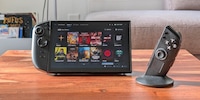

Asus ROG Ally X review: Steam Deck alternative, not replacement
The ROG Ally X trumps its predecessor in almost every respect, becoming my favourite Windows handheld. Compared to the Steam Deck, however, Asus’ gaming machine still has decisive drawbacks.
The first ROG Ally launched in a pitiful state. Asus’ software was so unfinished that it was bordering on fraud. Numerous updates later, the handheld has nevertheless developed into one of the most popular Steam Deck alternatives. With the Ally X, Asus is also improving its hardware. A number two at the end of the name is purposefully left out, it’s definitely more than a simple new edition.
- Display: 7-inch, IPS, 1920×1080 pixels, 500 nits, 120 Hz
- CPU: AMD Ryzen Z1 Extreme
- RAM: 24 GB LPDDR5X-7500
- Storage: 1 TB M.2 2280 PCIe 4.0, microSD slot
- TDP: 30 W
- Battery: 80 Wh
- Connections: 2×USB-C, 3.5-mm headphone socket
- Weight: 678 g
- Other: fingerprint scanner
The display and chip are identical to the predecessor. You also get a Full HD picture with a fast 120 Hz refresh rate. The working memory has been increased from 16 to 24 gigabytes. Its internal memory has even doubled to one terabyte. The directional pad can now be moved in eight directions instead of four. Its proprietary port for external graphics cards has given way to another USB-C port. Chargers up to 100 watts are supported. And finally, the battery has been increased from 40 Wh to an impressive 80 Wh. According to Asus, it’s the largest battery ever added into a handheld.
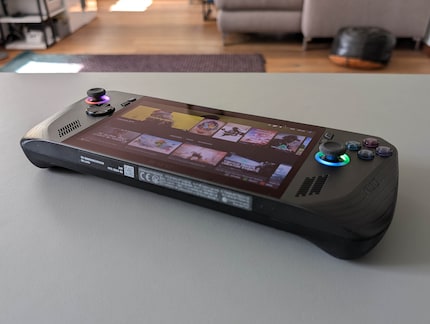
Source: Philipp Rüegg
These upgrades are reminiscent of the Steam Deck OLED. However, that also included a decisive display upgrade, which I’d also have liked for the Ally X. But even so, impressive improvements. However, you’ll also have to pay CHF/EUR 200 more than for its predecessor. And a carrying case isn’t included in the price.
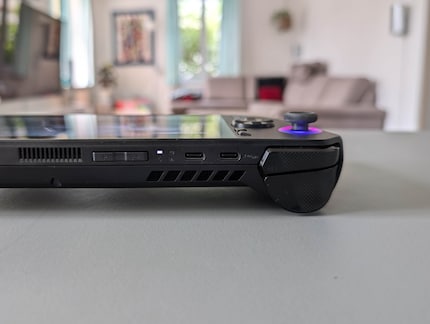
Source: Philipp Rüegg
Handy, but not innovative
Visually, the Ally X is inconspicuous – especially the black version that Asus provided me with. Only the four buttons A, B, Y, X bring some colour into play. Of course, the two analogue sticks still light up – which I immediately turn off. When I’m playing games, I get annoyed if something lights up right next to the display.
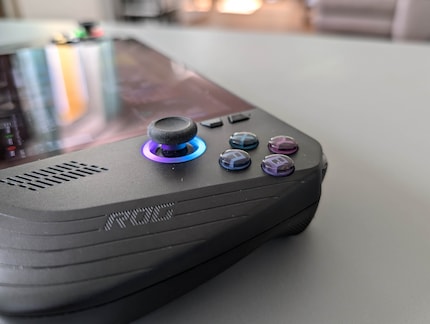
Source: Philipp Rüegg
Compared to its predecessor, the Ally X weighs 80 grammes more, now making it heavier than the Steam Deck. It isn’t a lightweight, and less ergonomic than Valve’s device. Overall, however, it feels good to hold and, unlike with the Legion Go, my hand never falls asleep.
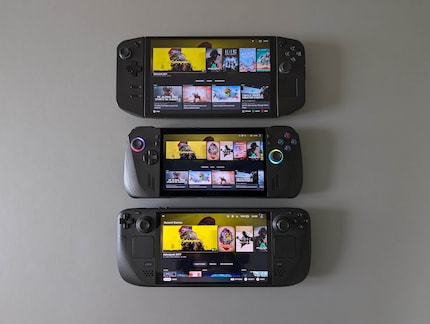
Source: Philipp Rüegg
The four buttons for in-game menus, quick settings and Armoury Crate – Asus’ user interface – could be positioned a little better. They’re a little too far away from the analogue sticks and face buttons, so pressing them quickly and without contorting yourself is tricky. The volume buttons on the top could also be placed closer to my hands.
There are two additional buttons on the back, which I can easily reach with my middle fingers. Too bad Asus didn’t increase the number to four like the competition.
The buttons and sticks are comfortable to use. However, the face buttons are a bit too loud for my tastes. Depending on how often or firmly I press the buttons, they’re almost grating. Fortunately, I’m usually so focused on my game or the in-game sound that I don’t notice. The directional pad is more annoying. It occasionally squeaks when I move it quickly from right to left. Maybe I’ll have to play with greasy potato chip hands to get it going again.
What’s completely missing are touchpads like on the Steam Deck or the Legion Go. I sorely miss them in both Windows and games that rely on mouse control. The vibration motor is merely satisfactory, the ROG Ally X isn’t very delicate in its rattling. I don’t expect dual-sense controller vibes, but a little more complexity would be nice. Finally, there’s a fingerprint scanner in the power button. It’s perfectly positioned and almost always unlocks the device the first time. And pretty quickly at that.
Crisp display and solid speakers
As mentioned, the display hasn’t changed at all. Thanks to Full HD, games look somewhat sharper than on the lower-resolution Steam Deck, which is the same size. Despite its larger display, the Legion Go has around ten per cent higher pixel density. Nevertheless, Valve’s handheld stands out visually thanks to the significantly higher-contrast OLED display. I can’t emphasise often enough what a big difference this makes. If you can’t make a direct comparison like me, you’ll also be satisfied with Asus’ IPS display. However, I didn’t notice the 30 Hertz higher refresh rate compared to the Steam Deck. After all, very few games run smoothly enough to benefit from this.
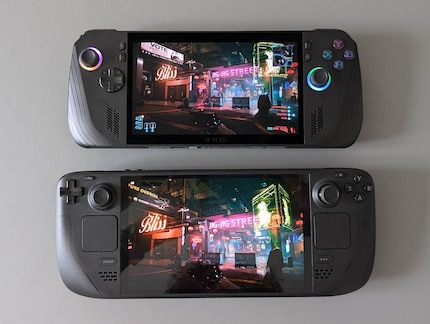
Source: Philipp Rüegg
The speakers sound solid for such a small device. Definitely better than the tinny clatter of Lenovo’s Legion Go. However, the sound isn’t quite as powerful as that of the Steam Deck.
A big leap forward from the first device
The ROG Ally X runs on Windows. Once you’ve completed the installation, you’ll have the same system available as on your laptop or PC. Since Windows isn’t designed for handhelds, Asus, like all manufacturers, supplies its own software. You launch Armoury Crate SE with its dedicated button on the right-hand side of the display. There, you can easily install launchers such as Steam, Epic or Battle.net and then start them. You can also find all installed games here, meaning you don’t have to switch back and forth between different launchers. You’ll end up doing it anyway, though, since you can only install games from individual services.
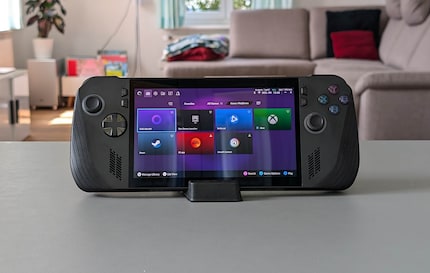
Source: Philipp Rüegg
You can also find updates and settings for the device such as lighting, the fan, etc. here. The app is clearly laid out, responds quickly and offers all the important functions. Command Center, which I launch with a button on the left edge of the display, also serves its purpose. From there, I can quickly change performance profiles, controls, resolution or the FPS display.
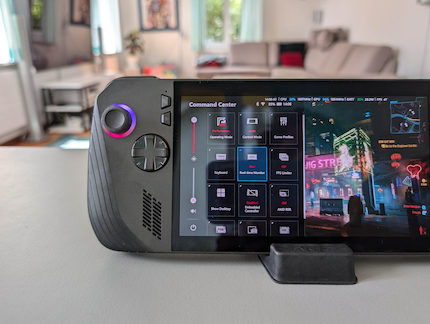
Source: Philipp Rüegg
The ROG Ally X works much more reliably than its predecessor. Games usually start without problems too. The controls are correct, programs rarely freeze and the Asus software is a useful addition to Windows.
What I like about Steam Deck is how console-like it is to use. Everything comes together perfectly. Like all other Windows handhelds, the Ally X still can’t come close to this user experience. It starts with the fact that you have to install updates or change settings in a billion different places. In Windows itself, in the Asus app, in the Microsoft Store and, of course, in all installed launchers. After all, it’s a Windows device, with all its advantages and disadvantages.
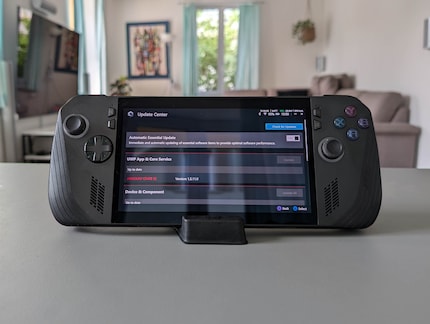
Source: Philipp Rüegg
However, this also means that, unlike the Steam Deck, I can install updates or games when the display is switched off. Download speeds are also very pleasing. I’ve been struggling for years to achieve more than 50 MB/s on the Steam Deck. The Ally X zooms straight ahead with its maximum 100 MB/s – wonderful.
Quiet and lasts longer
The fans on the first ROG Ally were already among the quietest on the market, and the successor is in no way inferior. The new cooling system promises even better performance. If the fans do turn up during demanding games, they never whistle or roar annoyingly. It’s a bit annoying that the Turbo profile switches on as soon as I connect a power supply – even if a game doesn’t need that much power. I haven’t found out where I can adjust this yet. The heat emitted also remains within limits, and the housing never gets uncomfortably warm.
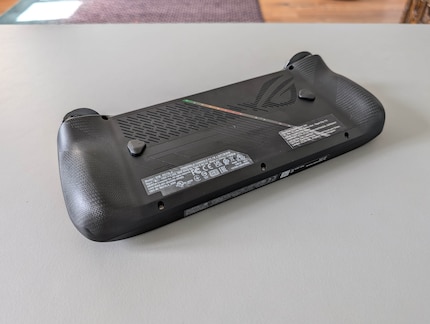
Source: Philipp Rüegg
The battery lasts significantly longer than the first Ally thanks to its double capacity. However, the runtime depends largely on processor performance. Games that only draw a few watts manage a few more hours than intensive AAA games. Asus promises 2.7 hours for the latter and up to 14 hours when watching Netflix. Even if I haven’t explicitly tried this out, it should match.
As with my comparison of the original Steam Deck to the OLED version, I tested performance during an intense scene in Cyberpunk 2077. I set the brightness to maximum and activated the most powerful Turbo profile on the Ally. After 70 minutes, that was that, about the same time as the default Steam Deck. The OLED version lasts 130 minutes and benefits from a more energy-efficient display and low refresh rate.
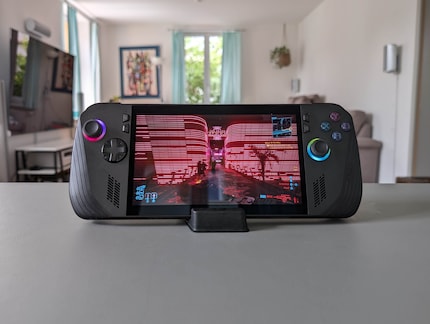
Source: Philipp Rüegg
The Ally X juices up quickly thanks to charging power up to 100 W. However, this didn’t work with my Hyper-Juice charger. This one charges so slowly that I can’t even play at the same time. Once again, a mix of charger and USB cable incompatibility. Thankfully, Asus includes a power supply unit, even if it only manages 65 watts.
A speedy Ally
The ROG Ally X uses the same AMD chip as most Windows handhelds. Differences in performance are primarily related to the cooling and available TDP. Unsurprisingly, the Ally X is significantly faster than the Steam Deck thanks to its stronger chip. Ghost of Tsushima reaches almost twice as many FPS. The Ally also delivers around 40 per cent more performance in Cyberpunk 2077. In comparison with other Windows handhelds, it ranks in the top third. It doesn’t come close to the Ayaneo KUN, but it clearly beats the Legion Go.
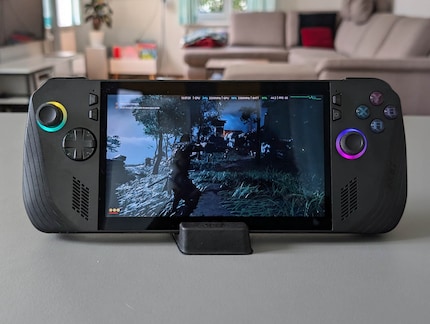
Source: Philipp Rüegg
Since Asus uses a 16:9 instead of a 16:10 display, I can’t compare identical resolutions. I took the next best one, 1366×768. This setting offers almost the same number of pixels as the Steam Deck, which has a resolution of 1280 × 800. I also tested it with the Ally X’s standard resolution of 1920 × 1080.
Ally X with turbo preset at 30 W TDP.Good ol’ Windows
Although the Ally X works reliably overall, unexpected behaviour or minor bugs aren’t uncommon. And here are the most common ones:
Sometimes the keyboard doesn’t appear when I want to type something. Or it appears twice. First the Steam one, then Windows. Occasionally a menu doesn’t open. Once, I couldn’t adjust the volume. Analogue stick illumination only stayed off after repeated deactivation. However, when I charge the device and the display is off, the sticks still flash, so I have to turn it over. During Ghost of Tsushima, I got distorted audio several times, and during Thank Goodness you’re here, the Ally X vibrated constantly. Restarts always solve such problems.
Keyboard shortcuts I created don’t work reliably. After waking up from standby, controls stopped responding a few times or the game closed itself. Standby is also the Achilles’ heel of the Ally X. It works most of the time, but errors occur too often. That’s why I prefer to end games manually when taking a break. This is the only way I can be sure that my save status isn’t lost. This is one of the main advantages of the Steam Deck, alongside its ease of use. The device also regularly goes into sleep instead of hibernation mode, which extends the wake-up time. Sleep mode is deactivated both in the Windows settings and in Armoury Crate. Tips are always welcome.
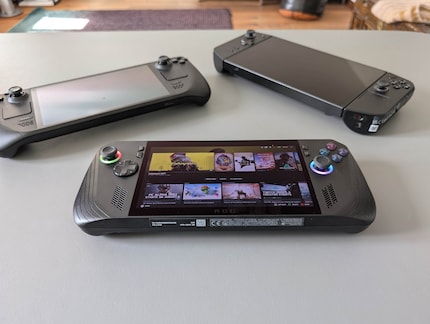
Source: Philipp Rüegg
In a nutshell
Given the necessary patience, a solid handheld
With the ROG Ally X, Asus delivers the best Windows handheld currently available. The device is handy, fast and quiet. The mountain of problems the predecessor had to contend with at launch has largely disappeared. Today, the Ally X usually works reliably and quickly. Asus’ Armoury Crate software is a useful addition and, combined with the Command Center, makes using Windows much more pleasant.
Windows remains a blessing and a curse. I can still install anything I want on it, including titles from Game Pass or the Microsoft Store. This is its main advantage over Steam Deck. Nevertheless, that device remains unbeaten in terms of user experience. Steam OS controls are worlds better than Windows handheld ones. Standby mode is also practically flawless there, in contrast to the ROG Ally X. Apart from an OLED display, Asus can’t improve too much. The ball’s now in Microsoft’s court. I hope they’ll finally develop a suitable operating system for handhelds.
Pro
- fast and quiet
- 120 Hz display
- can install all the PC games I want
- Armoury Crate makes operation easier
Contra
- Windows still causes plenty of problems
- standby mode not reliable enough
- buttons a little too loud and directional pad squeaks
- no touchpad

As a child, I wasn't allowed to have any consoles. It was only with the arrival of the family's 486 PC that the magical world of gaming opened up to me. Today, I'm overcompensating accordingly. Only a lack of time and money prevents me from trying out every game there is and decorating my shelf with rare retro consoles.


